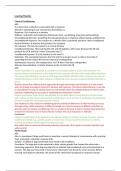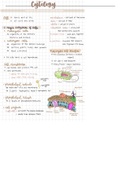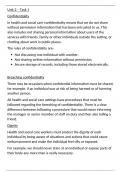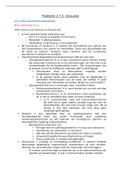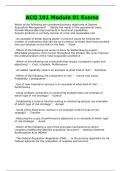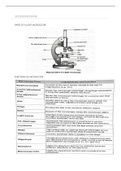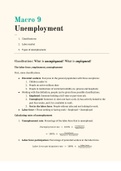Classical Conditioning
A01:
It is about how a stimulus is associated with a response.
Stimulus- Something in our environment that affects us
Response- Our reaction to a stimulus
Reflexes- Automatic and involuntary behaviours (Fear, eye blinking, knee-jerk and breathing)
Unconditioned Stimulus- Something that already produces a response without being conditioned to
Unconditioned response- Our reaction to a stimulus that is automatic and hasn’t been conditioned
Neutral Stimulus- A stimulus that produces no response
No response- The lack of reaction to a neutral stimulus
Conditioned Stimulus- After pairing the UCS and NS together, after some time just the NS will
produce the UCR and that’s when it becomes the CS
Conditioned response- It is the reaction to the now CS
Extinction- The association between the UCS and CS no longer occurs so after a few trials of
separating the two stimuli the learned response is extinguished
Spontaneous recovery- the reappearance of a CR after it has been extinguished
Stimulus Generalisation- A similar stimulus to the CS elicits the CR
A03:
Pavlov found that it was possible to condition an automatic reflex to occur in the presence of a
neutral stimulus (metronome) as the dogs learnt to associate salivation with sound rather than food.
This shows that behaviour can be learnt through associating a stimulus with a response to produce a
required behaviour which makes classical conditioning more accurate in explaining how behaviour is
learnt.
Bandura found that children learnt aggression through observation and imitation of a role model
and not through association between a stimulus and response. This shows that behaviour is not due
to associations but due to copying same sex role models when they display behaviour which makes
classical conditioning less accurate at explaining how behaviour is learnt.
Watson and Rayner found that it was possible to train little Albert to associate fear of loud noises
with a white rat. This shows that classical conditioning is more accurate in explaining how behaviour
is learnt through the association between stimuli.
One weakness is that classical conditioning ignores individual differences in that learning can occur
through unique reflex responses of different people as it may be because of different reactions to
stimulus and not classical conditioning, this is a weakness because it doesn't explain how behaviour
is learnt for everyone such as those who do not have the usual responses to stimulus
Conclusion
Classical conditioning can be applied in educational settings to enhance learning. Teachers can use
conditioned stimuli (e.g., specific sounds or visual cues) to signal specific behaviours or actions,
creating associations that facilitate learning and recall
less useful when it comes to influencing voluntary behaviours that require conscious intention and
wilful control
Pavlov Study
A01:
Aim- to investigate if dogs could learn to associate a neutral stimulus of a metronome with receiving
food, producing a salivation response (CR)
Sample- 35 different dog breeds that were raised in lab conditions
Procedure- The dogs had a tube attached to their salivary glands that drained the saliva into a
measuring apparatus. Each dog was placed in an isolated and soundproof room and restrained in a
harness. The dog was fed a bowl of meat and a metronome was heard for a few seconds. Before
learning- food leads to salivation, the sound of the metronome produced no response. During
, learning- food is repeatedly paired with the metronome. After learning- metronome leads to
salivation.
Results- Dogs learnt to salivate at the sound of the metronome even when the food was not
presented. Conditioned dogs started to salivate 9 seconds after hearing the metronome. After 45
seconds, 11 drops of saliva were produced.
Conclusion- it was possible to condition an automatic reflex to occur in the presence of a neutral
stimulus as the dogs learnt to associate salivation with sound rather than the food.
A03:
Pavlov’s study on whether dogs could learn to associate a neutral stimulus of a metronome with
receiving food was high in controls as all dogs, after being placed in isolation in a room were
presented food and a metronome which led to a salivation response. Therefore, this minimises the
effect of extraneous variables such as reacting to other dogs’ behaviour so he can be sure that the
association of food with the metronome caused salivation allowing cause and effect between the
stimulus and response to be established increasing the validity of the study.
Pavlov’s results gained about classical conditioning may not be as applicable to associations in
humans due to physiological differences between dogs and humans. This can be considered a
weakness as results may not be representative of humans accurately so can not explain how
associations between a stimulus and response occur in humans which means he results are low in
generalisability.
Pavlov’s study on classical conditioning had a standardised procedure as all dogs were tested before
learning to see that the sound of the metronome produced no response, this was repeatedly paired
with the food which led to salivation. This is a strength as the all the dogs were treated in the same
way throughout the procedure which means the study is high in reliability as it is easy to replicate
the study to check for consistency into association.
Pavlov’s study into classical conditioning used dogs which had a tube attached to their salivary
glands and each dog was placed in an isolated, soundproof room and restrained in a harness during
a series of trails. This is a weakness as the treatment of the dogs was inhumane and unethical which
reduces the scientific credibility of the results on classical conditioning on association with salivation
to a metronome.
Conclusion
By associating a desired behaviour with a previously neutral stimulus, it becomes possible to elicit
the desired response without the need for explicit reinforcement or punishment
Classical conditioning is often specific to the context in which it occurs. The conditioned response
may not easily transfer to different environments or situations.
Classic Study- Watson and Rayner
A01:
Aim- to investigate if they could classically condition a fear response in a child towards an animal by
presenting it to an infant child with a loud noise
Sample- Little Albert, 9 months old male infant at the start of the research. Raised mostly in the
hospital environment as this is where his mother worked. He was reported to be stolid and
unemotional
Procedure- Little Albert went through a series of emotional tests and was found not to show any fear
response in any situation and the conditioning process started 2 months later. Session 1, 2,3,4 and 5.
Session 1- In a lab environment Little Albert was presented with the white rat. When he went to
touch the rat a bar was struck loudly behind his head. This was done twice.
Session 2- A week later the pairing of the loud noise and the white rat was exposed 5 times. As a
control he was exposed to building blocks which he showed no fear response.
Session 3- After 5 days it was tested on his response to the rat when a loud bar was struck behind his
head. And then further tested with other objects such as wooden blocks, a rabbit, a dog cotton wool
and a fur coat in the same way.

